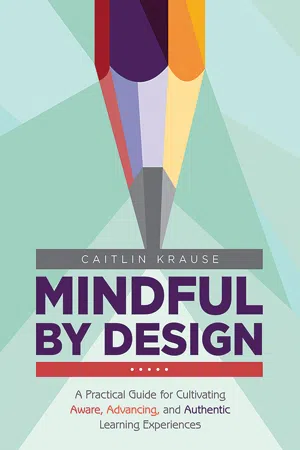
Mindful by Design
A Practical Guide for Cultivating Aware, Advancing, and Authentic Learning Experiences
- 224 pages
- English
- ePUB (mobile friendly)
- Available on iOS & Android
Mindful by Design
A Practical Guide for Cultivating Aware, Advancing, and Authentic Learning Experiences
About This Book
Take mindfulness beyond the buzzword and spark powerful learning environments!
This resource explores how mindfulness can improve teaching and learning, and helps students develop 21st century skills including creativity, entrepreneurship, innovation, and communication. Readers will learn how to cultivate a personal mindfulness practice that reflects their individuality, and how to create a community of care and respect through mindfulness.
Mindfulness is the building of three capacities: awareness, advancement, and authenticity. Built upon these core capacities, Mindful by Design provides 24 detailed exercises for teachers and students, including step-by-step mindfulness lessons embedded into specific curriculum areas, ready to implement immediately. This book demystifies mindfulness and allows educators to inspire powerful learning environments.
Frequently asked questions
Information
Part I
Chapter 1 Mindfulness: Beyond the Buzzword
A Practical Definition of Mindfulness
Aware
of self; of others; of senses and context
Advancing
active, curious, insightful stretching, outward and inward
Authentic
accepting of self and others, without judgment
- ◗ promoting presence (Aware)
- ◗ increasing focus (Advancing)
- ◗ boosting connection capacity for relational trust (Authentic)
Mindfulness involves mental focus and training. It is not a religion, though the word mindfulness has origins in Buddhism. In a secular way, it is truly addressing the mind itself and a way of heightening awareness.Some exercises related to mindfulness incorporate meditation, and many of the mindfulness meditation activities will focus on the breath as a guide and a focus. You don’t have to sit on the floor or assume any special physical position in order to exercise mindfulness—it can happen anywhere, anytime.Using mindfulness does not result in a weaker willpower, and it does not make you more passive or happy-go-lucky. In fact, mindfulness deepens the clarity with which you see the world and engage with it. It helps with everything from goal-setting to learning—with passion!
Mindful Qualities of Learning
- Attention management, greater awareness
- Increased focus and concentration, less attachment and reactivity to emotion
- Health and well-being, including calming abilities in stressful situations
- Conscious decision-making and greater compassion for self and others
Table of contents
- Cover
- Series
- Half Title
- Title Page
- Copyright Page
- Contents
- Acknowledgments
- About the Author
- Acknowledgements
- Introduction: Making a Difference
- Part I
- Chapter 1 Mindfulness: Beyond the Buzzword
- Chapter 2 Creating a Mindful Learning Environment
- Part II
- Chapter 3 Mindfulness for Teachers
- Chapter 4 Mindfulness in the Classroom and Community
- Part III
- Chapter 5 The Future of Mindfulness
- References
- Index
- Advertisement